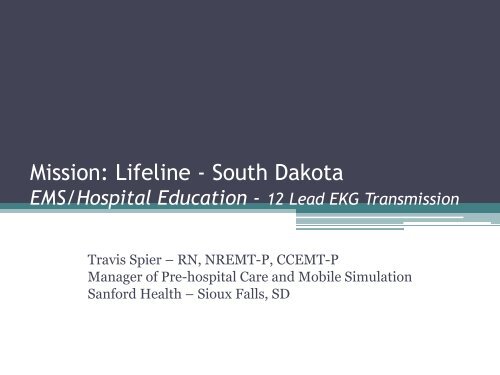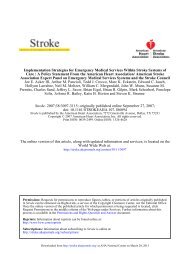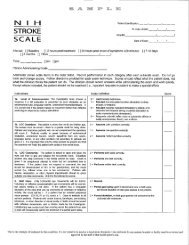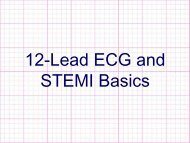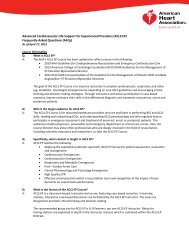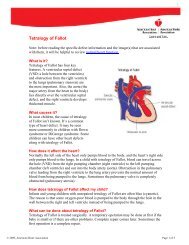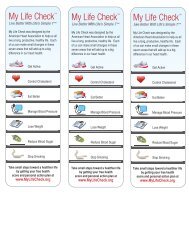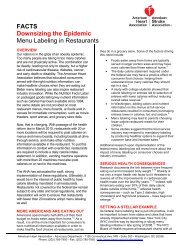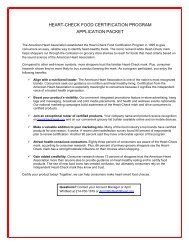12 Lead EKG Transmission - American Heart Association
12 Lead EKG Transmission - American Heart Association
12 Lead EKG Transmission - American Heart Association
You also want an ePaper? Increase the reach of your titles
YUMPU automatically turns print PDFs into web optimized ePapers that Google loves.
Mission: Lifeline - South Dakota<br />
EMS/Hospital Education - <strong>12</strong> <strong>Lead</strong> <strong>EKG</strong> <strong>Transmission</strong><br />
Travis Spier – RN, NREMT-P, CCEMT-P<br />
Manager of Pre-hospital Care and Mobile Simulation<br />
Sanford Health – Sioux Falls, SD
Disclosures<br />
Travis Spier – Education – Mission: Lifeline SD
Objectives<br />
• Identify the role of an EMS/facility provider<br />
within the SD Mission: Lifeline project<br />
• Identify the educational steps involved in<br />
acquisition, transmission and arrival of a prehospital<br />
<strong>12</strong> lead <strong>EKG</strong>
Project Mission Statement<br />
• AHA Mission Lifeline mission statement<br />
▫ A collaborative multidisciplinary effort organized to<br />
facilitate and develop processes for optimizing timely<br />
access to, and delivery of, appropriate care for<br />
STEMI patients that addresses a continuum from<br />
home to hospital and subsequent outpatient follow<br />
up.
Recognizing the Problem<br />
• Time is Muscle<br />
▫ South Dakota statistics<br />
• According the Center’s for Disease Control, South<br />
Dakota is in the Class 5 category for STEMI death<br />
rates in the nation,<br />
• Majority of heart muscle<br />
damage occurs within<br />
the first 2hrs of the crisis<br />
• My study and results<br />
of “T2B”
South Dakota – A Rural System of Care<br />
• Establish a comprehensive STEMI system<br />
linking EMS providers to receiving facilities and<br />
interventional care centers<br />
• Develop a successful and functional model for<br />
other states and systems to replicate<br />
• Working together as a healthcare team with a<br />
focus in identifying, managing, correcting and<br />
reporting on an acute cardiac emergency<br />
(STEMI)
Pre-hospital (EMS) Goals<br />
• A new and additional “ask” of EMS<br />
• Improving the timeliness for evaluating,<br />
treating, transporting a patient experiencing<br />
an acute cardiac emergency (STEMI)<br />
• Accurate lead placement to obtain an <strong>EKG</strong><br />
• Establishing steps to follow for transmitting<br />
an <strong>EKG</strong> on the monitor<br />
• Wires on for transport<br />
• Contact the hospital following transmission
Hospital Receiving Center Goals<br />
• Openly accept the <strong>EKG</strong> as it arrives from the<br />
out-of-hospital environment<br />
• Prompt decision making process of the EMS <strong>12</strong><br />
lead <strong>EKG</strong><br />
• Preparation for receiving and referring the<br />
patient<br />
• Transport arrangements (ground vs. air)<br />
• Treatment guidelines and order sets<br />
• Report the information, movement of data
A Successful System –<br />
Value/Role/Knowledge/Ownership<br />
• Assists in the improvement of timely cardiac care and<br />
management during a STEMI event<br />
• Provides prompt care that originates in the home of a<br />
patient who is experiencing an acute myocardial injury<br />
(STEMI)
The Role of EMS<br />
• Respond, care for and manage the cardiac<br />
patient outside the walls of the hospital<br />
• Demonstrate your role as a Physician Extender<br />
• Serving as the hands, eyes and ears of the physician<br />
medical director while caring for the cardiac patient<br />
in your community<br />
• Provide emergency care that meets the<br />
standards established for cardiac care, adheres<br />
to local guidelines and functions in the best<br />
interest of the patient
SD Mission Lifeline – Remember “Mick”<br />
• Opportunity to improve healthcare delivery and<br />
management of the acutely ill patient<br />
experiencing a cardiac emergency (STEMI) in<br />
the pre-hospital environment<br />
• Decreasing the time to STEMI management and<br />
treatment
Implementation Process<br />
• EMS/hospital startup in South Dakota<br />
▫ Equipment acquisition and equipment specific<br />
training (on-site in their community)<br />
▫ Mission Lifeline orientation and <strong>12</strong> <strong>Lead</strong> <strong>Transmission</strong><br />
Training (onsite in their community)<br />
▫ Participate in ongoing training and program<br />
improvement strategies (onsite in their communities)<br />
▫ Active participant in <strong>12</strong> lead acquisition and<br />
transmitting guidelines (hook in water = fish)<br />
▫ Ongoing training and skill maintenance that supports<br />
sustainability (outreach education collaboration)
What we already had in place…<br />
• Monthly EMS Education system<br />
• Healthcare facility support and affiliation<br />
• Benefit of being a small State<br />
• Great people willing to help others
South Dakota<br />
• Map of EMS and Hospitals
Theory of Practice<br />
• Timely assessment of the patient and acquisition<br />
of a <strong>12</strong> lead <strong>EKG</strong> by EMS providers.<br />
• Early transmission of the pre-hospital <strong>EKG</strong> into<br />
the emergency department’s receiving station<br />
followed by on-line communication<br />
• Early diagnosis and start of clinical care and<br />
management of the of the acutely ill cardiac<br />
patient.<br />
• Providing prompt treatment and interventions<br />
to prevent ischemic damage to the heart and<br />
decrease mortality caused by STEMI events.
Education Material<br />
EMS Agencies<br />
• Product specific education<br />
• MLSD STEMI Education<br />
• AHA STEMI Textbook<br />
• AHA Learn Rapid STEMI<br />
• Sample EMS Protocol<br />
• Sample EMS skill verification<br />
form<br />
• Education packet<br />
• Quick reference card<br />
• EMS Coach/Mentor<br />
Hospitals<br />
• Product education on<br />
receiving software<br />
• MLSD STEMI education<br />
• AHA STEMI Textbook<br />
• AHA Learn Rapid STEMI<br />
• Education packet<br />
• Lytic material<br />
• Quick reference card<br />
• Resource availability
Distribution of textbooks and key<br />
codes<br />
Telephone calls and emails<br />
• Number of EMS providers at each agency<br />
• Number of nurses at facilities<br />
• Number of providers at facilities<br />
• Books assigned to a location<br />
• Key code attached to a textbook<br />
• Roster logs participant and book
Setting up the Key Manager
Implementing the Process
Establishing a Guideline<br />
Have a established guideline to assist an EMS<br />
provider in determining when to obtain/transmit a<br />
<strong>12</strong> lead <strong>EKG</strong><br />
▫ Chest pain<br />
▫ Shortness of breath<br />
▫ Syncope or near syncope<br />
▫ Weakness<br />
▫ DKA<br />
▫ Diaphoresis<br />
▫ Respiratory failure<br />
▫ Ventricular failure (CHF)<br />
▫ Stroke<br />
▫ Overdose<br />
▫ Altered level of consciousness<br />
▫ Suspected electrolyte<br />
disturbances<br />
▫ Pre and post cardio-version of<br />
stable patients<br />
▫ Post cardiac arrest with return<br />
of spontaneous circulation<br />
▫ Blunt chest trauma (only after<br />
transport or more urgent care)<br />
▫ Irregular rhythm<br />
Non-discriminating or judgmental
Components for EMS Success<br />
• Trained EMS providers<br />
▫ Familiar with use and function of equipment<br />
▫ Proficient in <strong>EKG</strong> lead placement<br />
▫ Knowledgeable in the steps of transmitting a <strong>12</strong> lead<br />
• Equipment capable of obtaining a <strong>12</strong> lead <strong>EKG</strong><br />
▫ Cardiac Monitor<br />
• AED / Defibrillator / Monitor/ <strong>12</strong> <strong>Lead</strong> / Transmit capability<br />
• Sync cardiovert / TCP / ETCO2 / NIBP / SpO2<br />
▫ Capable of transmitting a <strong>12</strong> lead via established<br />
wireless platform<br />
• <strong>Transmission</strong> source to send the <strong>12</strong> lead <strong>EKG</strong><br />
▫ Utilizing cellular data technology
A Process that is Easy…<br />
• What is common?
Community Based Education with<br />
EMS<br />
• Develop a basis for educational understanding<br />
▫ Anatomy and physiology of the heart<br />
▫ Evolution of a heart attack<br />
▫ <strong>Lead</strong> placement<br />
▫ Transmitting components<br />
▫ Components of an <strong>EKG</strong><br />
▫ STEMI markers<br />
▫ Hands on opportunities<br />
▫ Ongoing practice
<strong>Lead</strong> Placement<br />
• Emphasis on correct lead placement and<br />
positioning of the patient
Transmitting the <strong>EKG</strong><br />
• Acquire and transmit <strong>EKG</strong> to the receiving<br />
center along with follow-up communication<br />
• Hospitals need time too…
Working Together as a Team<br />
• Early access to diagnostic <strong>12</strong> lead <strong>EKG</strong><br />
• Early notification of treatment team at receiving<br />
facility and tertiary center<br />
• Initiate treatment plan by receiving facility<br />
• Integrated data system merging information<br />
with EMStat5 software<br />
• Reporting capabilities and data collection<br />
• Initial and ongoing educational opportunities
Community based education with<br />
the hospital<br />
• Pre-hospital system<br />
• Value of the EMS <strong>12</strong> lead <strong>EKG</strong><br />
• Interpretation timeline<br />
• The local STEMI patient<br />
• STEMI management and practice<br />
• Transfer arrangements<br />
• Lytic utilization<br />
• <strong>EKG</strong> acquisition in the ER<br />
• Repeat <strong>EKG</strong>
A System for Assessing a <strong>12</strong> <strong>Lead</strong><br />
I<br />
SEE<br />
ALL<br />
LEADS<br />
Inferior <strong>Lead</strong>s II, III, AVF<br />
Septal <strong>Lead</strong>s V1, V2<br />
Anterior <strong>Lead</strong>s V3, V4<br />
Lateral <strong>Lead</strong>s V5, V6, I, AVL<br />
I<br />
V1 V4<br />
aVR<br />
Lateral Septal Anterior<br />
II aVL V2 V5<br />
Inferior Lateral Septal Lateral<br />
III aVF V3 V6<br />
Inferior Inferior Anterior Lateral
AMI Localization<br />
I<br />
II<br />
III<br />
aVR<br />
aVL<br />
aVF<br />
V1<br />
V2<br />
V3<br />
V4<br />
V5<br />
V6<br />
Anterior: V3, V4<br />
Septal: V1, V2<br />
Inferior: II, III, AVF<br />
Lateral: I, AVL, V5, V6
Working Together<br />
• <strong>American</strong> <strong>Heart</strong> <strong>Association</strong><br />
▫ Mission: Lifeline South Dakota<br />
• Patient and Community Education<br />
• EMS providers<br />
• Receiving Facilities<br />
• Tertiary PCI Cardiac Centers<br />
• Mission: Lifeline South Dakota


